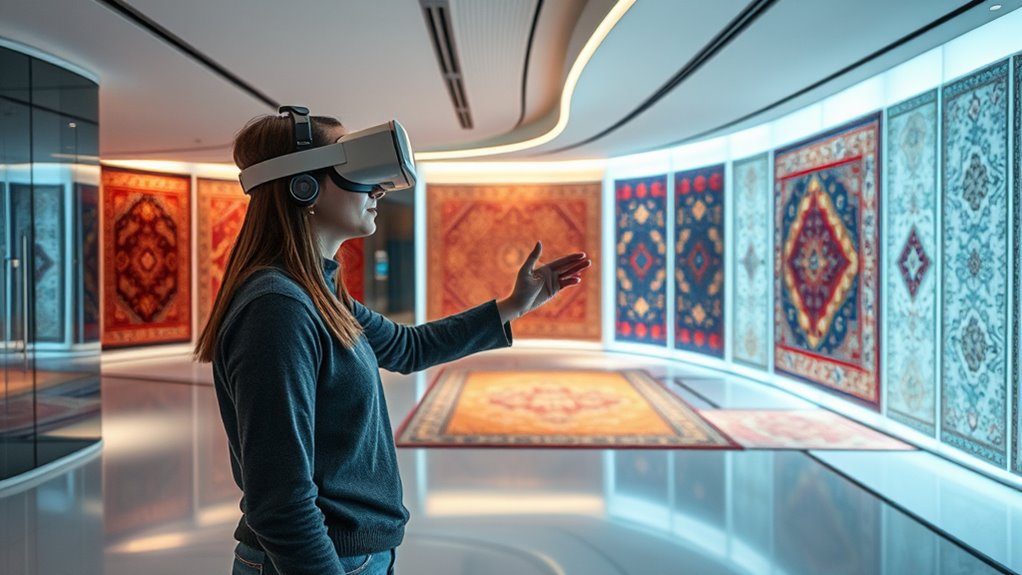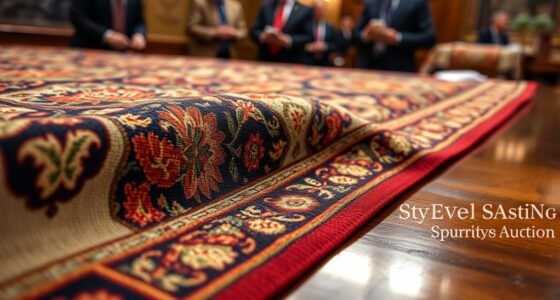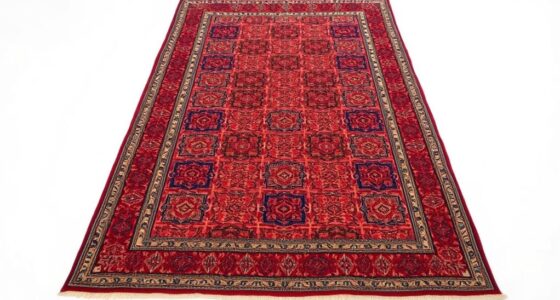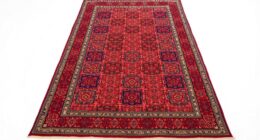In high-end showrooms, VR technology lets you experience rugs virtually with stunning realism. You can visualize how different styles, colors, and textures fit your space, often using immersive features like 3D visualization and augmented reality. While the tech offers a more confident, tailored shopping experience, challenges like high costs and equipment limitations still exist. Explore how these innovative tools are shaping luxury interior design and what future trends could bring next.
Key Takeaways
- High-end showrooms are adopting VR to provide immersive, realistic rug visualization that enhances customer experience and decision confidence.
- Advanced 3D modeling, high-resolution rendering, and haptic feedback are used to create lifelike virtual rug displays.
- Challenges include high costs, hardware limitations, setup complexity, and technical expertise requirements for effective VR integration.
- VR allows virtual try-on, accurate scale, and texture visualization, bridging the gap between online and in-store shopping.
- Future trends focus on improving realism, accessibility, and collaboration through technological advancements in AR and digital craftsmanship.
The Rise of Virtual Reality in Luxury Retail
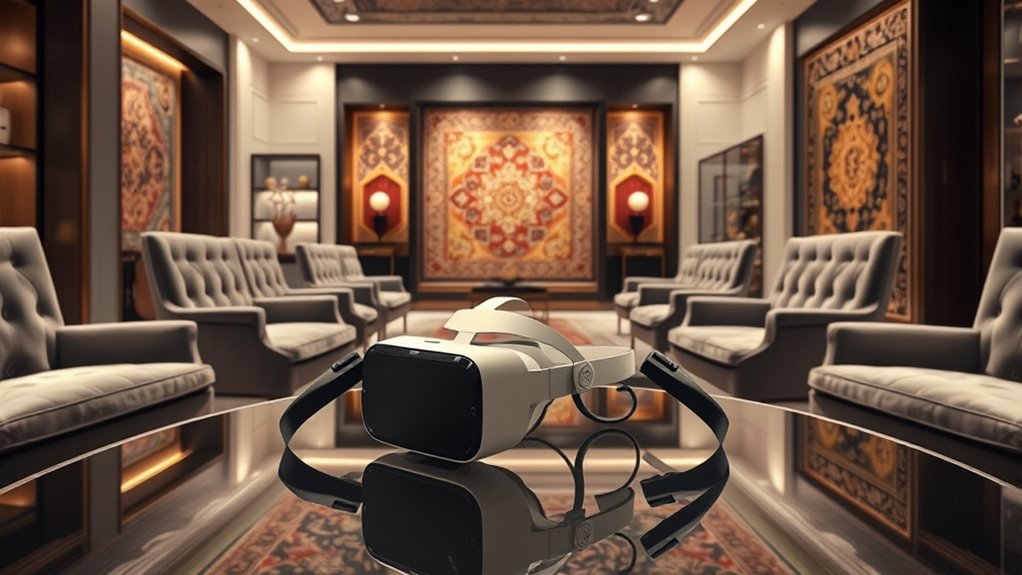
Virtual reality is transforming luxury retail by offering immersive experiences that bridge the gap between online shopping and in-store visits. With virtual try-on features, you can see how a rug fits your space without leaving your home. VR enhances sensory engagement, making you feel as if you’re physically in a high-end showroom. You can walk around the rug, view it from different angles, and even simulate how it looks under various lighting conditions. This technology gives you a richer understanding of texture, color, and scale, helping you make confident decisions. The rise of virtual reality in luxury retail isn’t just about convenience; it’s about creating a memorable, engaging shopping journey that combines the best of digital innovation with sensory immersion. Incorporating mindful decluttering principles can also help you better organize your space and make more intentional choices when selecting new pieces.
How VR Transforms the Rug Shopping Experience
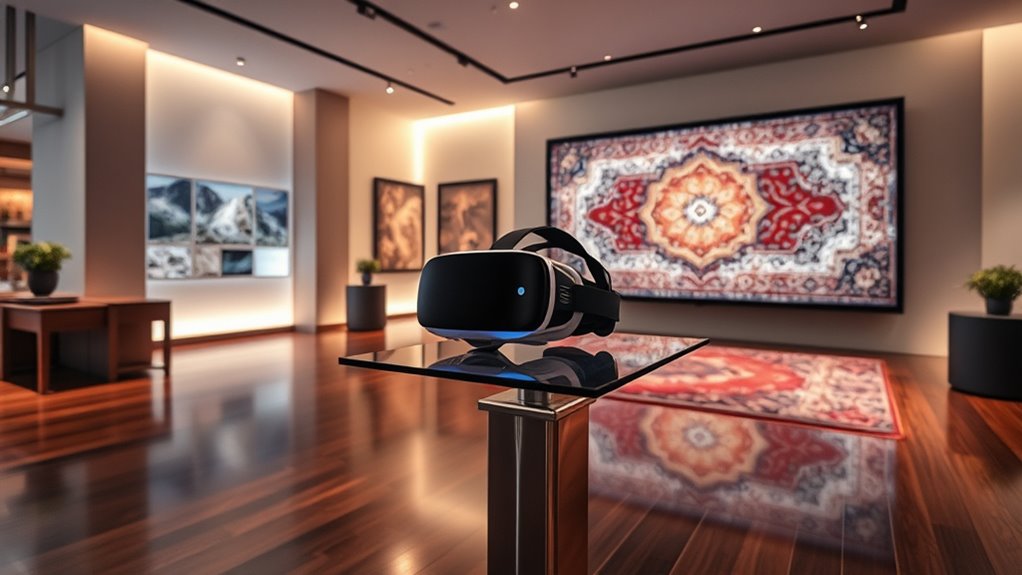
With VR, you can see how a rug looks in your space using immersive visualization techniques. This makes it easier to choose the right style and size without leaving your home. As a result, your selection process becomes faster, more confident, and personalized. Incorporating visual indicators into VR platforms can further enhance the accuracy of how rugs will fit and look in real-world environments.
Immersive Visualization Techniques
Immersive visualization techniques revolutionize the rug shopping experience by allowing you to see how a rug will look in your space before making a purchase. Using VR, you can walk around and view the rug from different angles, getting a true sense of scale and color. Haptic feedback enhances this experience by simulating textures, so you can feel the rug’s surface without touching it. This adds realism and confidence to your decision. Additionally, these techniques enable social sharing, letting you stream your virtual visit to friends or designers for instant feedback. The combination of immersive visuals, tactile cues, and social interaction transforms traditional shopping into an engaging, personalized process, helping you make more informed choices and ensuring your new rug fits perfectly in your home. Incorporating color accuracy into VR visualization can further improve the fidelity of your virtual rug preview.
Enhanced Selection Process
VR streamlines the rug selection process by providing instant access to a wide range of options tailored to your space and style preferences. With virtual showrooms, you can explore multiple rug designs without leaving your home. Augmented reality helps you see how different rugs fit and complement your existing decor. Here’s how VR enhances your choices:
- Quickly narrow down options by size, color, or pattern using interactive filters.
- Visualize rugs in your space with augmented reality, ensuring perfect fit and style.
- Access a broader selection than physical showrooms, including exclusive designs.
- Incorporate design elements like rugs into your overall farmhouse bedroom aesthetic to create a cohesive look.
This seamless experience saves time and reduces guesswork, making your rug shopping more efficient and enjoyable. VR transforms traditional methods into a dynamic, personalized journey, elevating your buying confidence.
Benefits of Immersive Virtual Showrooms for Clients
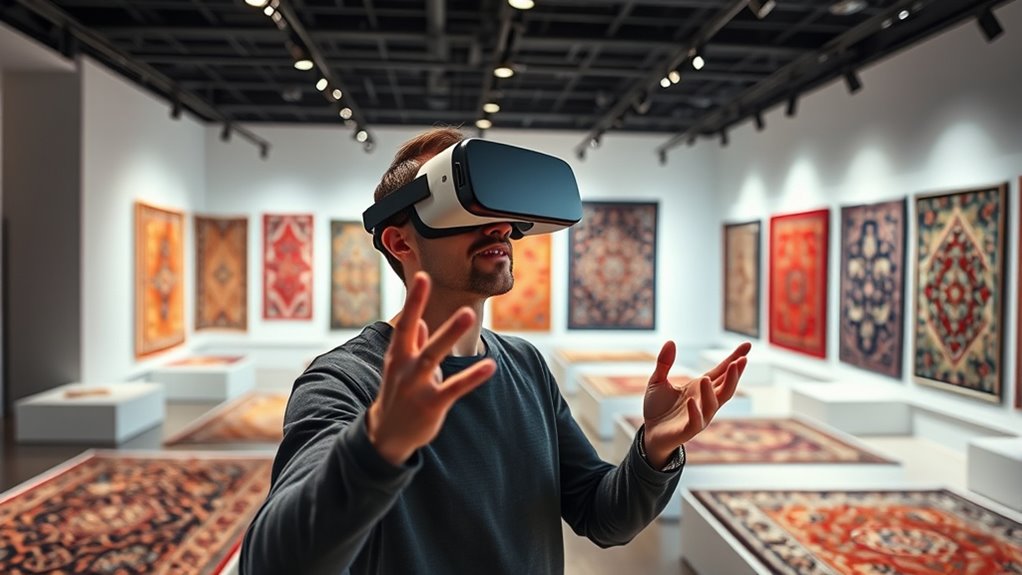
With immersive virtual showrooms, you can see how rugs will look in your space with incredible detail and accuracy. This makes it easier to visualize different styles and colors before making a decision. Plus, the streamlined process saves you time and reduces the hassle of traditional shopping. Incorporating professional equipment ensures high-quality visuals and audio, enhancing the overall experience.
Enhanced Visualization Experiences
Because clients can now explore rugs in a highly realistic virtual environment, they gain a clearer understanding of how a piece will look and feel in their space. Virtual showrooms enhance visualization by combining immersive technology with augmented reality, allowing you to see how rugs fit your decor. With this setup, you can:
- Visualize different rug sizes and styles instantly
- Test color options in various lighting conditions
- Experience true scale and texture from any angle
- Understanding credit card terms is essential when making online purchases to ensure transparency and avoid hidden fees.
These features make decision-making more confident and efficient. Virtual showrooms offer an interactive, engaging way to evaluate rugs without physical samples. By leveraging augmented reality and immersive environments, you gain a more exhaustive sense of how a rug complements your space, saving time and reducing uncertainty.
Streamlined Selection Process
Immersive virtual showrooms simplify the rug selection process by allowing you to evaluate multiple options quickly and accurately. With interactive design features, you can virtually place rugs in your space, adjusting size, color, and pattern in real time. This boosts customer engagement, making the experience more personal and efficient. Instead of flipping through catalogs, you explore diverse styles seamlessly, narrowing choices faster. The table below highlights key benefits:
| Benefit | Explanation |
|---|---|
| Faster Decisions | Quickly compare rugs side-by-side in your space. |
| Improved Accuracy | See true colors and textures virtually. |
| Customization | Adjust size and design to fit your room. |
| Enhanced Engagement | Interact directly with options, increasing satisfaction. |
| Reduced Return Rates | Make confident choices, minimizing returns. |
This streamlined process saves time and enhances your confidence in selecting the perfect rug. Understanding virtual reality technology further enhances the realism of immersive showrooms, making the experience more convincing and reliable.
Technology Behind VR Rug Displays
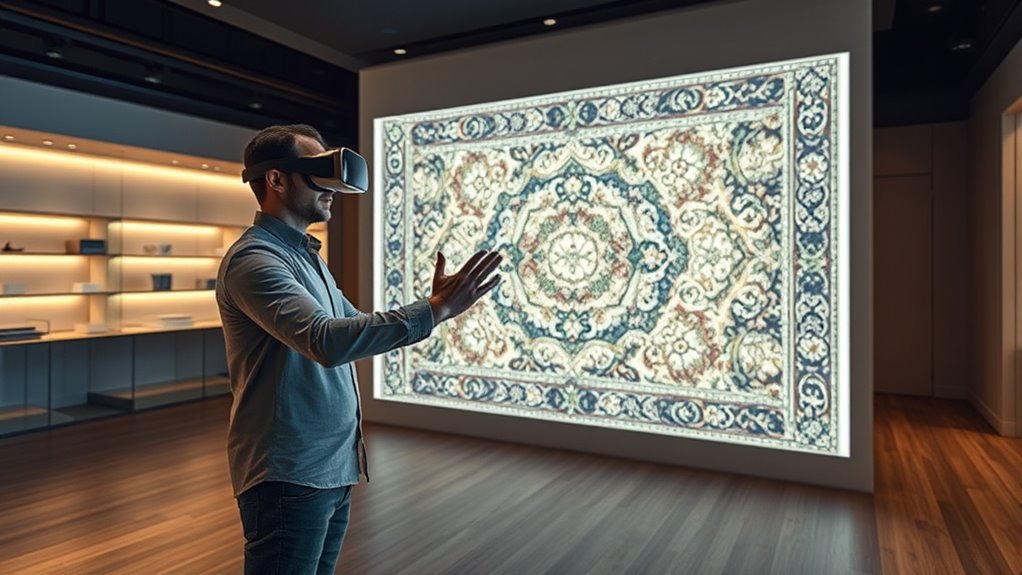
The technology behind VR rug displays combines advanced 3D modeling, high-resolution rendering, and precise motion tracking to create realistic virtual environments. You’ll experience immersive interactions enhanced by haptic feedback, which simulates the texture and firmness of rugs. Spatial mapping allows the system to accurately understand your surroundings, ensuring the virtual rug aligns perfectly with your real-world space. Dog names can also inspire creative options for customizing virtual decor themes within the showroom. Key features include:
- Realistic haptic feedback to simulate different rug textures
- Precise spatial mapping for accurate placement and scale
- Seamless motion tracking for fluid navigation within the virtual showroom
Together, these elements enable an authentic viewing experience, making it easier for you to visualize rugs in your space without physically handling them. This blend of technology transforms how you perceive high-end rug displays in virtual environments.
Challenges and Limitations of VR Adoption
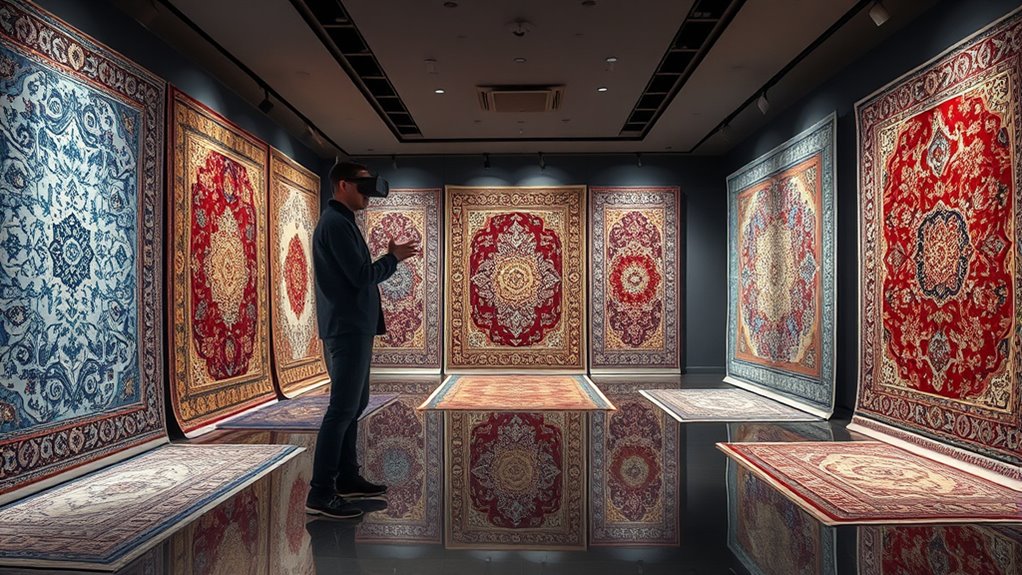
Despite its promising potential, VR rug displays face several significant challenges that hinder widespread adoption. One major obstacle is cost barriers; high-quality VR hardware and software can be expensive, limiting access for many showrooms. Additionally, hardware limitations pose a problem—current headsets often lack the resolution and realistic haptic feedback needed to accurately represent textures and details of rugs. These technical constraints can reduce the immersive experience and make it harder for clients to visualize products effectively. Setup complexity also discourages some businesses from adopting VR solutions, requiring technical expertise and space that may not be available. Furthermore, the technological limitations currently restrict the full potential of VR in high-end showrooms, making it difficult to realize its full potential in the luxury interior design market.
Future Trends in VR and High-End Interior Design
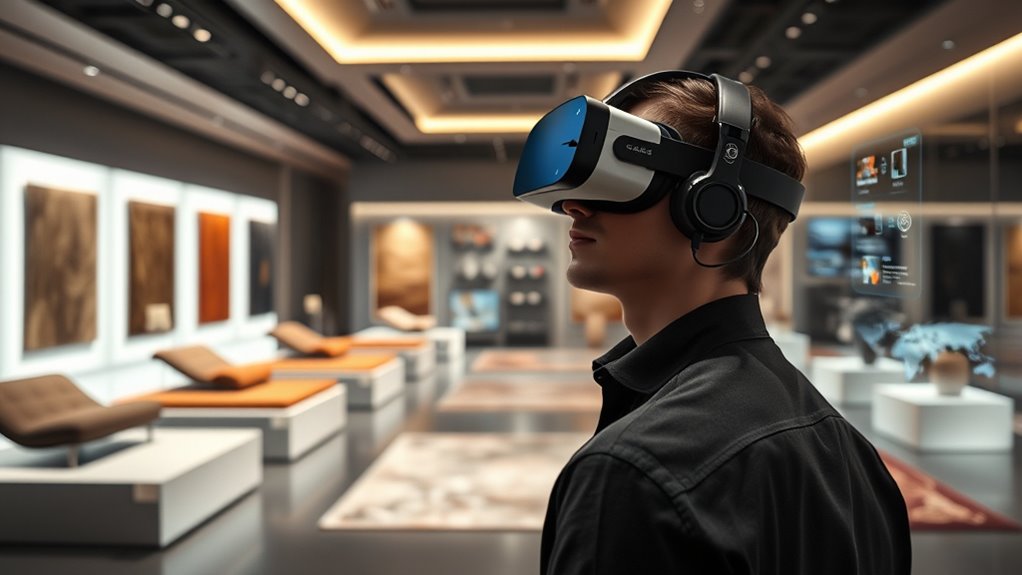
As technology continues to advance, the future of VR in high-end interior design looks promising, with innovations poised to overcome current limitations. You’ll soon see augmented reality seamlessly blending with VR, enabling you to visualize rugs and decor in real time within actual spaces. Digital craftsmanship will become more refined, allowing for highly detailed virtual textures and finishes that mimic real-world materials. Additionally, incorporating dynamic communication exercises into virtual interactions can improve client-designer collaboration, making the experience more engaging and responsive.
Frequently Asked Questions
How Do VR Rug Displays Compare to Physical Showroom Visits?
When comparing VR rug displays to physical showroom visits, you’ll notice virtual realism allows for a highly immersive experience, showcasing intricate details and textures. This technology boosts client engagement by enabling you to visualize rugs in various settings instantly. While physical visits offer tactile feedback, VR provides convenience and the ability to explore more options quickly. Overall, VR enhances your experience, making your decision process more interactive and efficient.
What Is the Cost of Implementing VR Technology for High-End Showrooms?
When considering the cost of implementing VR technology, you should focus on a thorough cost analysis that includes initial technology investment, software development, and hardware costs. While upfront expenses can be significant, VR offers a scalable solution that enhances customer experience and reduces physical showroom costs over time. Balancing these factors helps you determine the long-term value of integrating VR into your high-end showroom, making it a strategic investment.
How Do Clients Perceive the Realism of VR Rug Representations?
You might wonder how clients perceive the realism of VR rug representations. Generally, you’ll find that high-quality VR offers excellent visual realism, which positively influences client perception. When the textures, colors, and details closely mimic real rugs, clients feel more confident in their selections. Your goal should be to optimize visual realism in VR to enhance client satisfaction, making the virtual experience feel authentic and trustworthy.
What Training Is Required for Staff to Operate VR Showroom Systems?
You’ll need thorough staff training to master VR showroom systems, ensuring they can confidently operate and troubleshoot the technology. Expect to dive deep into technical support, learning everything from headset setup to software navigation. This training isn’t just important—it’s essential, because without it, your team might struggle to deliver seamless experiences. Mastering these skills transforms your staff into tech-savvy guides, turning virtual rug displays into immersive, high-end showcases that wow every client.
Are There Privacy Concerns Related to VR Data Collection and Usage?
You should consider privacy concerns related to VR data collection and usage. Data security is essential to protect customer information, especially when sensitive data is involved. Always make sure you obtain user consent before collecting any data, clearly explaining how it will be used. By prioritizing user consent and maintaining strong data security measures, you build trust and comply with privacy regulations, preventing potential legal issues and safeguarding your reputation.
Conclusion
As you step into the evolving landscape of luxury retail, virtual reality becomes your gateway to a world where rugs are no longer confined to the showroom floor. It’s like holding a universe of textures and patterns in your palm, transcending physical boundaries. Embrace this digital revolution, knowing it’s shaping the future of high-end interior design—where technology and artistry dance in perfect harmony, turning your vision into reality with every immersive glance.
